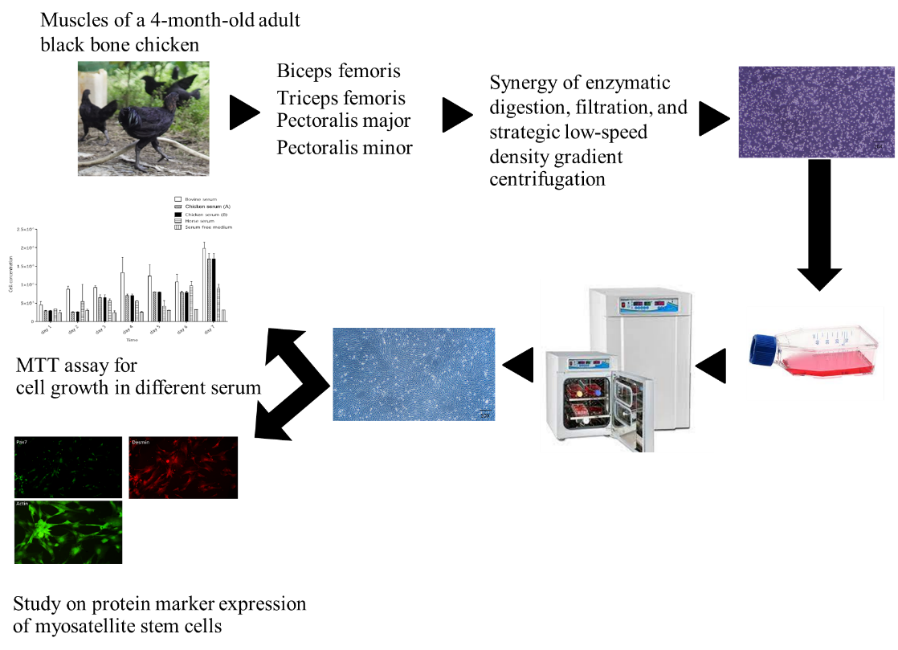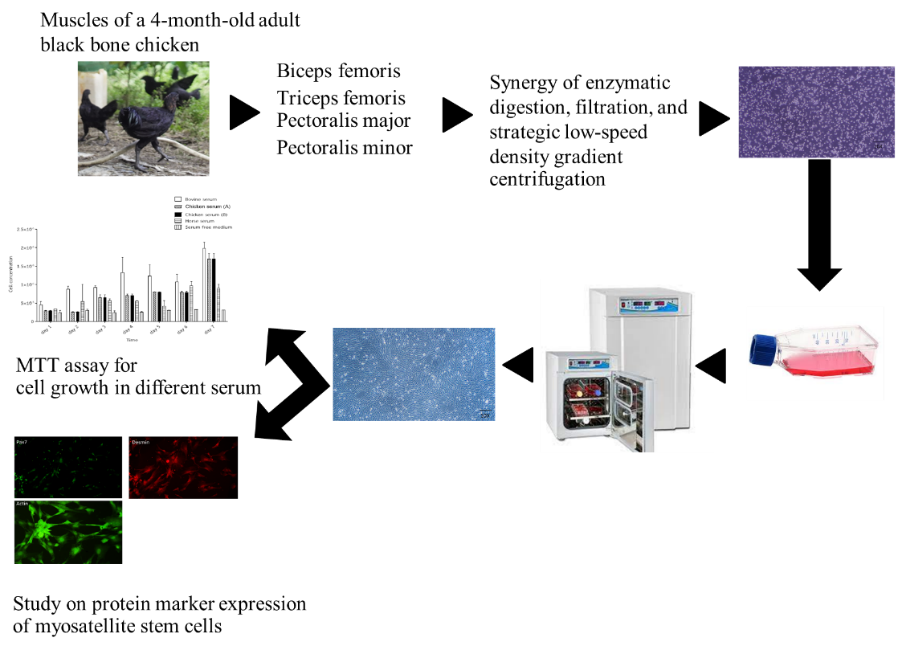Characterization of Myosatellite Stem Cells from Black Bone Chicken and Effect of Different Animal Serums on Growth Performance
DOI:
https://doi.org/10.48048/tis.2024.7420Keywords:
Stem cell, Isolation, Black bone chicken, Cultured chicken meat, Animal serumAbstract
Isolation of muscle stem cells (myosatellite stem cells) of black bone chickens using enzymatic digestion, the pronase, and screening by low-speed centrifugation process combined with 40 μm cell strainer filtration showed that this method was able to separate chicken muscle stem cells efficiently. The results proved that the isolated cells were myosatellite stem cells expressing marker genes, c-met, Pax7, MyoD, and myogenin, by RT-PCR assay. Additionally, immunofluorescence staining with monoclonal antibodies confirmed the isolated cells were MSCs, with positive staining for canonical markers proteins: Pax7, Desmin, and actin. Evaluating the influence of fetal bovine serum (FBS), horse serum (HS), and chicken serum (CKS) supplements on MSC proliferation revealed that FBS emerged as the most effective despite its escalating cost and emerging need for alternatives. Notably, Chicken Serum (CKS) demonstrated potential as an alternative, closely following the cell proliferation rate achieved by FBS. Our findings affirm the efficacy of the devised isolation method and highlight the potential of using chicken serum in cell culture protocols.
HIGHLIGHTS
This research established a technique for isolating myosatellite stem cells from black bone chickens through enzymatic processes combined with gradient methods. Centrifugation aids in obtaining a purer isolation of these stem cells and allows for the evaluation of various animal serums’ effects. In cell cultures, the performance of chicken serum showed no significant difference compared to bovine serum.
GRAPHICAL ABSTRACT

Downloads
Metrics
References
M Jankowski, P Mozdziak, J Petitte, M Kulus and B Kempisty. Avian satellite cell plasticity. Animals 2020; 10, 1322.
S Eleuteri and A Fierabracci. Insights into the secretome of mesenchymal stem cells and its potential applications. Int. J. Mol. Sci. 2019; 20, 4597.
A Svoradova, V Zmrhal, E Venusova and P Slama. Chicken mesenchymal stem cells and their applications: A mini review. Animals 2021; 11, 1883.
X Fu, G Liu, A Halim, Y Ju, Q Luo and AG Song. Mesenchymal stem cell migration and tissue repair. Cells 2019; 8, 784.
X Fu, H Wang and P Hu. Stem cell activation in skeletal muscle regeneration. Cell. Mol. Life Sci. 2015; 72, 1663-77.
A Zannetti, G Benga, A Brunetti, F Napolitano, L Avallone and A Pelagalli. Role of aquaporins in the physiological functions of mesenchymal stem cells. Cells 2020; 9, 2678.
BJ Li, PH Li, RH Huang, WX Sun, H Wang, QF Li, J Chen, WJ Wu and HL Liu. Isolation, culture and identification of porcine skeletal muscle satellite cells. Asian Australas. J. Anim. Sci. 2015; 28, 1171-7.
S Skrivergaard, MK Rasmussen, M Therkildsen and JF Young. Bovine satellite cells isolated after 2 and 5 days of tissue storage maintain the proliferative and myogenic capacity needed for cultured meat production. Int. J. Mol. Sci. 2021; 22, 8376.
Z Yablonka-Reuveni, LS Quinn and M Nameroff. Isolation and clonal analysis of satellite cells from chicken pectoralis muscle. Dev. Biol. 1987; 119, 252-9.
Z Zhao, X Yu, J Jia, G Yang, C Sun and W Li. miR-181b-5p may regulate muscle growth in tilapia by targeting myostatin b. Front. Endocrinol. 2019; 10, 812.
N Motohashi, Y Asakura and A Asakura. Isolation, culture, and transplantation of muscle satellite cells. Front. Vet. Sci. 2014, https://doi.org/10.3791/50846.
D Montarras, J Morgan, C Collins, F Relaix, S Zaffran, A Cumano, T Partridge and M Buckingham. Direct isolation of satellite cells for skeletal muscle regeneration. Science 2005; 309, 2064-7.
CR Pilgrim, KA McCahill, JG Rops, JM Dufour, KA Russell and TG Koch. A review of fetal bovine serum in the culture of mesenchymal stromal cells and potential alternatives for veterinary medicine. Front. Vet Sci. 2022, https://doi.org/10.3389/fvets.2022.859025.
Y Zhanqiu and X Hai-Rong, Culture conditions and types of growth media for mammalian cells. Biomedical Tissue Culture. In: L Ceccherini-Nelli and B Matteoli. IntechOpen, London, 2012.
RHGAVD Biggelaar, GJA Arkesteijn, VPMG Rutten, WV Eden and CA Jansen. In vitro chicken bone marrow-derived dendritic cells comprise subsets at different states of maturation. Front. Immunol. 2020, https://doi.org/10.3389/fimmu.2020.00141.
C Bai, L Hou, F Li, X He, M Zhang and W Guan. Isolation and biological characteristics of beijing fatty chicken skeletal muscle satellite cells. Cell. Comm. Adhes. 2012; 19, 69-77.
PJ Sweeney and JM Walker. Pronase (EC 3.4.24.4). Meth. Mol. Biol. 1993; 16, 271-6.
R Harwood. Cell separation by gradient centrifugation. Int. Rev. Cytol. 1974; 38, 369-403.
Y Matsuyoshi, M Akahoshi, M Nakamura, R Tatsumi and W Mizunoya. Isolation and purification of satellite cells from young rats by percoll density gradient centrifugation. Meth. Mol. Biol. 2019; 1889, 81-93.
B Baquero-Perez, SV Kuchipudi, RK Nelli and KC Chang. A simplified but robust method for the isolation of avian and mammalian muscle satellite cells. BMC Cell Biol. 2012; 13, 16.
Z Li, M Mericskay, O Agbulut, G Butler-Browne, L Carlsson, LE Thornell, C Babinet and D Paulin. Desmin is essential for the tensile strength and integrity of myofibrils but not for myogenic commitment, differentiation, and fusion of skeletal muscle. J. Cell biol. 1997; 139, 129-44.
X Zheng, H Baker, WS Hancock, F Fawaz, M McCaman and E Pungor. Proteomic analysis for the assessment of different lots of fetal bovine serum as a raw material for cell culture. Part IV. Application of proteomics to the manufacture of biological drugs. Biotechnol. Progr. 2006; 22, 1294-300.
CY Fang, CC Wu, CL Fang, WY Chen and CL Chen. Long-term growth comparison studies of FBS and FBS alternatives in six head and neck cell lines. PLoS One 2017; 12, e0178960.
L Pezzanite, L Chow, G Griffenhagen, S Dow and L Goodrich. Impact of three different serum sources on functional properties of equine mesenchymal stromal cells. Front. Vet. Sci. 2021; 8, 634064.
R Sereika, R Bobiniene, V Semaška, D Gudavičiute and D Vencius. Chemical composition study of standard chicken serum. Veterinarija Ir Zootechnika 2016; 74, 55-8.
J Ren, D Ward, S Chen, K Tran, P Jin, M Sabatino, PG Robey and DF Stroncek. Comparison of human bone marrow stromal cells cultured in human platelet growth factors and fetal bovine serum. J. Translational Med. 2018; 16, 65.

Downloads
Published
How to Cite
Issue
Section
License
Copyright (c) 2023 Walailak University

This work is licensed under a Creative Commons Attribution-NonCommercial-NoDerivatives 4.0 International License.






